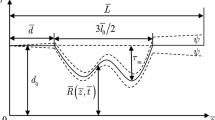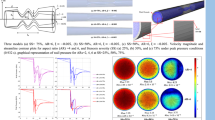Abstract
Investigation of couple stress fluid flow through \(\omega \)-shaped stenosed artery addresses many issues of blood flow in particular and circulatory system in general. In this model, physics of the flexible nature of the arterial tapered wall has been incorporated. The effects of pulsatile pressure gradient and stratification in both dynamic viscosity and couple stress viscosity are considered. To make the model more effective and realistic permeable stenosis, slip velocity and vanishing couple stresses at the arterial wall are also incorporated. The numerical solution of the transformed governing equations are obtained by using the finite difference method. The velocity profiles, the volumetric flow rate, the resistance to the flow and the wall shear stress are obtained numerically for various values of fluid and geometric parameters.























Similar content being viewed by others
References
Akbar, N.S., Nadeem, S., Ali, M.: Jeffrey fluid model for blood flow through a tapered artery with a stenosis. J. Mech. Med. Biol. 11(03), 529–545 (2011)
Beavers, G.S., Joseph, D.D.: Boundary conditions at a naturally permeable wall. J. Fluid Mech. 30(01), 197–207 (1967)
Bennett, L.: Red cell slip at a wall in vitro. Science 24, http://refhub.elsevier.com/S0997-7546(14)00108-3/sbref20 (1967)
Brunn, P.: The velocity slip of polar fluids. Rheologica Acta (1975). doi:10.1007/BF01515899
Chakravarty, S., Mandal, P.K.: Two-dimensional blood flow through tapered arteries under stenotic conditions. Int. J. Non-Linear Mech. 35(5), 779–793 (2000)
Chakravarty, S., Datta, A., Mandal, P.: Analysis of nonlinear blood flow in a stenosed flexible artery. Int. J. Eng. Sci. 33(12), 1821–1837 (1995)
Formaggia, L., Quarteroni, A., Veneziani, A.: Cardiovascular Mathematics: Modeling and Simulation of the Circulatory System, vol. 1. Springer, Berlin (2010)
Fossum, E., Høieggen, A., Moan, A., Nordby, G., Velund, T.L., Kjeldsen, S.E.: Whole blood viscosity, blood pressure and cardiovascular risk factors in healthy blood donors. Blood Press. 6(3), 161–165 (1997)
Ismail, Z., Abdullah, I., Mustapha, N., Amin, N.: A power-law model of blood flow through a tapered overlapping stenosed artery. Appl. Math. Comput. 195(2), 669–680 (2008)
Kensey, K., Cho, Y.: Physical principles and circulation: hemodynamics. In: The Origin of Atherosclerosis: What Really Initiates the Inflammatory Process, pp. 33–50 (2007)
Koenig, W., Sund, M., Filipiak, B., Döring, A., Löwel, H., Ernst, E.: Plasma viscosity and the risk of coronary heart disease results from the monica-augsburg cohort study, 1984–1992. Arterioscler. Thromb. Vasc. Biol. 18(5), 768–772 (1998)
Layek, G., Mukhopadhyay, S., Gorla, R.S.R.: Unsteady viscous flow with variable viscosity in a vascular tube with an overlapping constriction. Int. J. Eng. Sci. 47(5), 649–659 (2009)
Mann, F.C., Herrick, J., Essex, H.E., Baldes, E.J.: The effect on the blood flow of decreasing the lumen of a blood vessel. Surgery 4, 249–252 (1938)
Mekheimer, K.S., Kot, MaE: The micropolar fluid model for blood flow through a tapered artery with a stenosis. Acta. Mech. Sin. 24(6), 637–644 (2008). doi:10.1007/s10409-008-0185-7
Reddy, J.R., Srikanth, D., Murthy, S.K.: Mathematical modelling of time dependent flow of non-newtonian fluid through unsymmetric stenotic tapered artery: effects of catheter and slip velocity. Meccanica 51(1), 55–69 (2016). doi:10.1007/s11012-015-0201-5
Reddy, J.R., Srikanth, D., Murthy, S.K.: Mathematical modelling of pulsatile flow of blood through catheterized unsymmetric stenosed arteryeffects of tapering angle and slip velocity. Eur. J. Mech. B/Fluids 48, 236–244 (2014a). doi:10.1016/j.euromechflu.2014.07.001
Ramana Reddy, J.V., Srikanth, D.: The polar fluid model for blood flow through a tapered artery with overlapping stenosis: effects of catheter and velocity slip. Appl. Bionics Biomech. 2015, 174387-1–174387-12 (2015). doi:10.1155/2015/174387
Reddy, J.V.R., Srikanth, D., Murthy, S.: Mathematical modelling of couple stresses on fluid flow in constricted tapered artery in presence of slip velocity-effects of catheter. Appl. Math. Mech. 35(8), 947–958 (2014b). doi:10.1007/s10483-014-1848-7
Shukla, G.S.J.B.: Peristaltic transport of a power-law fluid with variable consistency. J. Biomech. Eng. 104(3), 182–186 (1982). doi:10.1115/1.3138346
Siouffi, M., Pelissier, R., Farahifar, D., Rieu, R.: The effect of unsteadiness on the flow through stenoses and bifurcations. J. Biomech. 17(5), 299–315 (1984). doi:10.1016/0021-9290(84)90025-3
Sloop, G.D., Garber, D.W.: The effects of low-density lipoprotein and high-density lipoprotein on blood viscosity correlate with their association with risk of atherosclerosis in humans. Clin. Sci. 92(5), 473–480 (1997)
Solerte, S., Fioravanti, M.: Hemodynamic alterations in long-term insulin-dependent diabetic patients with overt nephropathy: role of blood hyperviscosity and plasma protein changes. Clin. Nephrol. 28(3), 138–143 (1987)
Srinivasacharya, D., Srikanth, D.: Effect of couple stresses on the flow in a constricted annulus. Arch. Appl. Mech. 78(4), 251–257 (2008a). doi:10.1007/s00419-007-0157-6
Srinivasacharya, D., Srikanth, D.: Effect of couple stresses on the pulsatile flow through a constricted annulus. C.R. Mech. 336(11), 820–827 (2008b)
Srinivasacharya, D., Srikanth, D.: Flow of micropolar fluid through catheterized artery: a mathematical model. Int. J. Biomath. 05(02), 1250,019 (2012a). doi:10.1142/S1793524511001611
Srinivasacharya, D., Srikanth, D.: Flow of micropolar fluid through catheterized arterya mathematical model. Int. J. Biomath. 5(02), 1250,019 (2012b)
Srivastav, V., Vishnoi, R., Mishra, S., Sinha, P.: Blood flow through a composite stenosis in catheterized arteries. Sci. Tech. 5, 55–64 (2010)
Srivastava, L.: Flow of couple stress fluid through stenotic blood vessels. J. Biomech. 18(7), 479–485 (1985)
Stokes, V.K.: Couple stresses in fluids. Phys. Fluids 9(9), 1709–1715 (1966). doi:10.1063/1.1761925
Taylor, T.W., Yamaguchi, T.: Three-dimensional simulation of blood flow in an abdominal aortic aneurysmsteady and unsteady flow cases. J. Biomech. Eng. 116(1), 89–97 (1994)
Tu, C., Deville, M.: Pulsatile flow of non-newtonian fluids through arterial stenoses. J. Biomech. 29(7), 899–908 (1996)
Young, D.F., Tsai, F.Y.: Flow characteristics in models of arterial stenoses i. steady flow. J. Biomech. 6(4), 395–410 (1973a). doi:10.1016/0021-9290(73)90099-7
Young, D.F., Tsai, F.Y.: Flow characteristics in models of arterial stenoses—II. Unsteady flow. J. Biomech. 6(5), 547–559 (1973b)
Acknowledgements
The author (PKM) gratefully acknowledge the partial financial support from Special Assistance Programme (SAP-III) sponsored by University Grants Commission (UGC), New Delhi, INDIA (Grant No. F.510/3/DRs-III/2015 (SAP-I)).
Author information
Authors and Affiliations
Corresponding author
Rights and permissions
About this article
Cite this article
Reddy, J.V.R., Srikanth, D. & Mandal, P.K. Computational Hemodynamic Analysis of Flow Through Flexible Permeable Stenotic Tapered Artery. Int. J. Appl. Comput. Math 3 (Suppl 1), 1261–1287 (2017). https://doi.org/10.1007/s40819-017-0415-4
Published:
Issue Date:
DOI: https://doi.org/10.1007/s40819-017-0415-4




